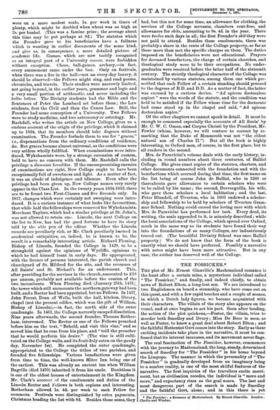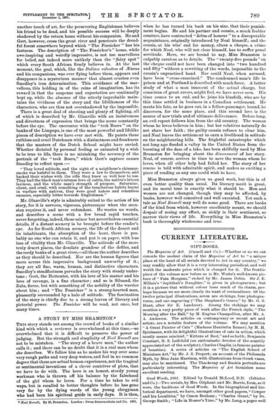THE FOSSICICER.*
THE plot of Mr. Ernest Glanville's Mashonaland romance is the hunt after a certain mine, a mysterious individual called " The Fossicker," and finally, and indeed chiefly, to obtain news of Robert Elton, a long.lost son. We are introduced to two Englishmen on board a steamship, who have come out on this quest, and with a few rapid touches and a couple of scenes, in which a Dutch lady figures, we become acquainted with their characters. The villain of the story also appears on the vessel, and at once begins to act his part. Soon after landing, the action of the plot quickens,—Foster, the villain, tries to murder both Smedley and Drury ; Miss De Beer is seen, as well as Foster, to know a great deal about Robert Elton ; and the faithful Hottentot Gert comes into the story. Early as these exciting incidents take place in the narrative, it must be con- fessed that its interest increases, and its movement never flags.
The real fascination of The Fossieker, however, commences with the journey to Mashonaland, the long, steady, determined search of Smedley for " The Fossicker" in his home beyond the Limpopo. The manner in which the personality of " The Fossicker" is gradually developed from an imaginary being to a sombre reality, is one of the most skilful features of the narrative. The first inquiries of the travellers excite merri- ment, but as civilisation recedes, the individual is " more and more," and expectancy rises as the goal nears. The last and most dangerous part of the search is made by Smedley and the faithful Gert, alone; and in this there is yet • The Fossicker : a Romance of Mashonaland. By Ernest Glanville. London : Chatto and Windns. another touch of art, for the persevering Englishman believes his friend to be dead, and his possible success will be deeply shadowed by the return home without his companion. He and Gert, however, cross the great river and penetrate the dread- ful forest somewhere beyond which " The Fossicker " has his fastness. The description of " The Fossicker's " home, while awe-inspiring and weirdly impressive, is not too marvellous for belief, not indeed more unlikely than the "fairy spot" which every South African firmly believes in. At the last moment, the goal, which, like the _Hallam volentem of 2Eneas and his companions, was ever flying before them, appears and disappears in a mysterious manner that almost crushes even Smedley's iron determination. This avoidance of the mar- vellous, this holding in of the reins of imagination, has its
reward in that the suspense and expectation are continually kept up, while the absence of the utterly improbable main- tains the vividness of the story and the lifelikeness of the characters, who are thus not overshadowed by the impossible. There is a great deal of shooting and plenty of fighting, all of which is described by Mr. Glanville with an incisiveness and directness of expression that brings the scene constantly before the eye. The encounter with the " trek Boers " on the
banks of the Limpopo, is one of the most powerful and lifelike pieces of description we have ever met with. He paints these ruthless and cruel Dutchmen with a distinctness and frankness that the masters of the Dutch School might have envied. Whether dictated by personal feeling or animated by a wish to be true to life, there is no mistaking the accuracy of the portrait of the " trek Boers," which Gert's capture causes Smedley to reflect upon :— " They loved solitude, and the sight of a neighbour's chimney- smoke was hateful to them. They were a law to themselves, and backed their wishes with the rifle they knew so well how to use. They had the black man's intense love of cattle, the native's inborn laziness, and the white man's strength of purpose. Saturnine, silent, and cruel, with something of the treacherous habits learnt in warfare with natives, they were good haters and relentless enemies, especially bitter towards Englishmen."
Mr. Glanville's style is admirably suited to the action of his story, for it is nervous, vigorous, picturesque when the occa- sion requires it, and never redundant. He wastes no words, and describes a scene with a few broad rapid touches, never forgetting, indeed, those minor but nevertheless essential details, if a distant scenery is be brought before the reader's eye. As for South African scenery, the life of the desert and its inhabitants, the absorption of the hunt, there is pro- bably no one who can retain it, and put it on paper, with less loss of vitality than Mr. Glanville. The solitude of the more truly desert places, the desolate grandeur of the defiles, and
the reedy banks of a great river,—all these the author describes as they should be described. Nor are the human figures that move across this impressive background unworthy of it ; they are all fine, warm, human, and distinctive characters. Smedley's steadfastness pervades the story with steady under- tone ; Gert, the Hottentot, with his love of his master and his love of revenge, is a fine character ; and so is Siluand, the Zulu, fierce, but with something of the nobility of the warrior
about him ; and " The Fossicker " is a strong-hearted man, pleasantly surrounded by a halo of solitude. The fascination of the story is chiefly due to a strong leaven of literary and pictorial power. The Fossicker will be read, not once, but many times.



















































 Previous page
Previous page